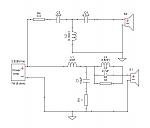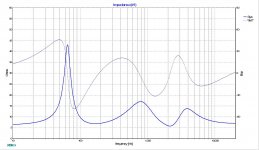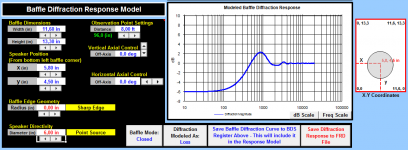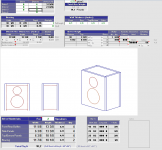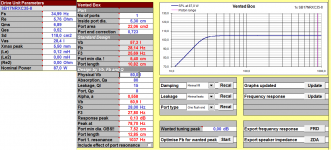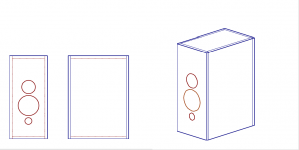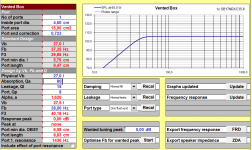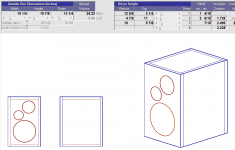Hi all
5 years ago I realixed my first speakers project.
I used SB17NRXC35-8 woofer and SB26STC-C000-4 twiter. Below all details about saled box and crossover filetrs.
Aldought it was my first project I have to say that the result was very good and during these years I enjoyed a lot of music 😀
Now I was thinking to re-design the box to use a port vented one. This because I would lime to improve the low level frequencies response.
Do you think that it is a good idea? Do you have suggestions?
5 years ago I realixed my first speakers project.
I used SB17NRXC35-8 woofer and SB26STC-C000-4 twiter. Below all details about saled box and crossover filetrs.
Aldought it was my first project I have to say that the result was very good and during these years I enjoyed a lot of music 😀
Now I was thinking to re-design the box to use a port vented one. This because I would lime to improve the low level frequencies response.
Do you think that it is a good idea? Do you have suggestions?
Attachments
Have you tried modelling a port on the existing box? - Although I think it'll need a bigger box...
yes, my idea is to increase the size of the box and add a port...
the main problem is that I don't remember which tools I have to use... 😛
the main problem is that I don't remember which tools I have to use... 😛
Unibox or Winisd can do the job
I think around 25 Litres tuned to ~ 41Hz should do the job (Vent 5Cm dia., 10Cm long)
I think around 25 Litres tuned to ~ 41Hz should do the job (Vent 5Cm dia., 10Cm long)
Last edited:
There seems to be a considerable inaccuracy in the Qts of this driver and its new mark 2 replacement (here 4 ohms)....
www.audioexcite.com >> SB Acoustics SB17NRXC35-8
Magpie-XT (SB17NRX2C35-4 with Peerless XT25TG30-04) – AmpsLab
Qts is nearer 0.5 on measurement.
Usual 2" X 4" and longer ports used. I don't know where that leaves you. Peaky bass, I'd think with reflex. Mike Chua was happy with it in 13L and 2" x 4", but a bass bump of +3dB.
www.audioexcite.com >> SB Acoustics SB17NRXC35-8
Magpie-XT (SB17NRX2C35-4 with Peerless XT25TG30-04) – AmpsLab
Qts is nearer 0.5 on measurement.
Usual 2" X 4" and longer ports used. I don't know where that leaves you. Peaky bass, I'd think with reflex. Mike Chua was happy with it in 13L and 2" x 4", but a bass bump of +3dB.
Well, using UniBox I added woofer parameters measured here
www.audioexcite.com >> SB Acoustics SB17NRXC35-8
the result in the attached image.
Bsically a 50L box with a port of 53mm diameter and 100mm height
To have 50L, I have would use the "golden ration" do the box dimensions would be H=56cm D=35cm W=22cm.
Does this make sense?
www.audioexcite.com >> SB Acoustics SB17NRXC35-8
the result in the attached image.
Bsically a 50L box with a port of 53mm diameter and 100mm height
To have 50L, I have would use the "golden ration" do the box dimensions would be H=56cm D=35cm W=22cm.
Does this make sense?
Attachments
so, I decided to realize a cabine of 57,3L as suggested by UniBox and WinISD.
Because I have a phisical limit to the height of the cabinet of 63cm, the final dimensions will be WxHxD = 28x63x44 with MDF of 1,9cm.
Now I have to decide where to place drivers and port...
Because I have a phisical limit to the height of the cabinet of 63cm, the final dimensions will be WxHxD = 28x63x44 with MDF of 1,9cm.
Now I have to decide where to place drivers and port...
Attachments
I think you try to tune the box to low for the possibilities of the driver, I would tune it not lower than 35Hz in a 35L cabinet, and then you will need 2 50mm diameter vents of 238mm to get a box where port chuffing is not an issue. If you make the port smaller you will have a lot of port noises even on low volume i think. That is something you may not be able to check in that sheet you use, but is easy to see in winisd.
And if you want it lower, you will be much better off with a real subwoofer and leave the cabinets like they are now.
And if you want it lower, you will be much better off with a real subwoofer and leave the cabinets like they are now.
Frankly, I don't know what is best to do in your situation.
For T/S parameters I tend to believe more to (reputable) mfg data than to independent one. This is because the equipment used for measuring T/S parameters do matter.
That said if T/S parameters for your units are near the mfg data, then the best vented box would be 20-25L tuned to 35Hz. OTOH if Qts is near 0.5 then the best box is a closed one, venting is not really an option you should consider.
Anyway, if you build another box, baffle width and driver placement (from top) should stay the same as the actual baffle. This will prevent baffle step and diffraction effect to change, and ***if*** the actual crossover is designed also with those effects, the you don't have to redesign the crossover.
One last word about Unibox/Winisd: what they suggest as optimum box is the one that has the lowest F3 possible, a so called maximal extension box. Unfortunately F3 doesn't have any practical use with our hearing (F6 is better suited), and in real conditions (room) the maximal extension box doesn't sound good. Have a look here: Zaph|Audio
Ralf
For T/S parameters I tend to believe more to (reputable) mfg data than to independent one. This is because the equipment used for measuring T/S parameters do matter.
That said if T/S parameters for your units are near the mfg data, then the best vented box would be 20-25L tuned to 35Hz. OTOH if Qts is near 0.5 then the best box is a closed one, venting is not really an option you should consider.
Anyway, if you build another box, baffle width and driver placement (from top) should stay the same as the actual baffle. This will prevent baffle step and diffraction effect to change, and ***if*** the actual crossover is designed also with those effects, the you don't have to redesign the crossover.
One last word about Unibox/Winisd: what they suggest as optimum box is the one that has the lowest F3 possible, a so called maximal extension box. Unfortunately F3 doesn't have any practical use with our hearing (F6 is better suited), and in real conditions (room) the maximal extension box doesn't sound good. Have a look here: Zaph|Audio
Ralf
Frankly, I don't know what is best to do in your situation.
For T/S parameters I tend to believe more to (reputable) mfg data than to independent one. This is because the equipment used for measuring T/S parameters do matter.
That said if T/S parameters for your units are near the mfg data, then the best vented box would be 20-25L tuned to 35Hz. OTOH if Qts is near 0.5 then the best box is a closed one, venting is not really an option you should consider.
in fact, even here it seems that the volume of the cabin is not so great..
Magpie-DX (SB17NRX2C35-4 with Peerless DX25TG59-04) – AmpsLab
Ok, let's do in this way, box of 27L tuned at 38Hz. WxHxD = 22x56x35cm
Anyway, if you build another box, baffle width and driver placement (from top) should stay the same as the actual baffle. This will prevent baffle step and diffraction effect to change, and ***if*** the actual crossover is designed also with those effects, the you don't have to redesign the crossover.
Ralf
the crossover do not consider the diffraction. So i will reuse it. To reduce diffraction my idea is to smooth edges.
Attachments
I still think that 27L is a bit too much. My suggestion of 20-25L (more 20 than 25), tuned to 35Hz has better power handling and integrates better to a typical room.
As for the box shape, it seems your new box will be significantly narrower than the original one. This alone will significantly shift the baffle step, A well designed crossover for one baffle won't work correctly for the other one. As I said before, if your crossover works satisfactorily now, you shouldn't alter the width of the baffle and the driver placement on the baffle as seen from the top of the baffle. You can extend the baffle below the woofer and/or increase the depth of the box.
Ralf
As for the box shape, it seems your new box will be significantly narrower than the original one. This alone will significantly shift the baffle step, A well designed crossover for one baffle won't work correctly for the other one. As I said before, if your crossover works satisfactorily now, you shouldn't alter the width of the baffle and the driver placement on the baffle as seen from the top of the baffle. You can extend the baffle below the woofer and/or increase the depth of the box.
Ralf
I still think that 27L is a bit too much. My suggestion of 20-25L (more 20 than 25), tuned to 35Hz has better power handling and integrates better to a typical room.
Understood.
As for the box shape, it seems your new box will be significantly narrower than the original one. This alone will significantly shift the baffle step, A well designed crossover for one baffle won't work correctly for the other one. As I said before, if your crossover works satisfactorily now, you shouldn't alter the width of the baffle and the driver placement on the baffle as seen from the top of the baffle. You can extend the baffle below the woofer and/or increase the depth of the box.
Ralf
This point is clear for me, but mantaing the same width has as consequence to have "wrong" proportion... the old cabinet was obliged by position in the previous room. Now I have the only height limit (63cm) so I can use golden ratio or in general I can follow some best practice...
I'm not so expert about diffraction, but I understood that it is possible to reduce the effect creating rounded edges and placing the center of tweeter not at the same distance of 3 edges.
So an idea can be the attached design WxHxD = 26x40x34cm (more or less)
Attachments
Last edited:
- Home
- Loudspeakers
- Multi-Way
- 2 way project improvement?
